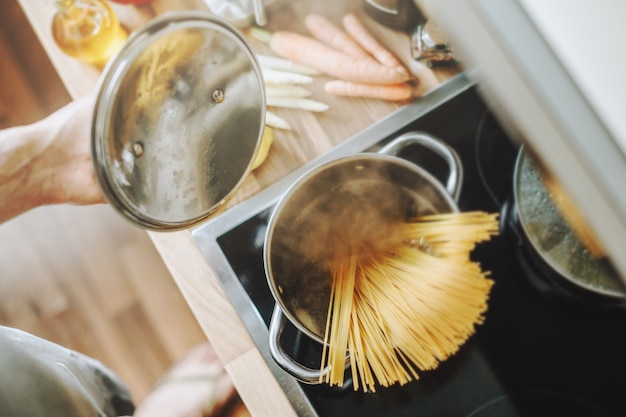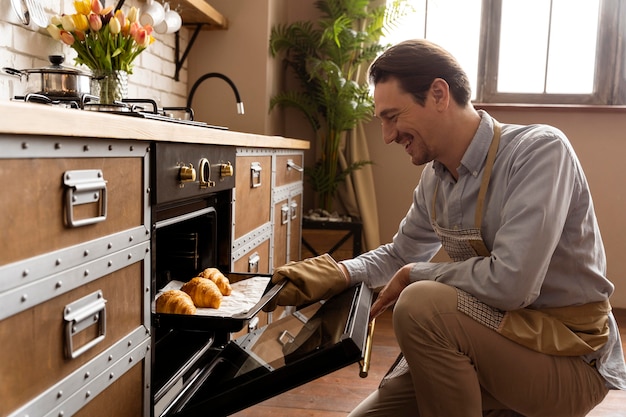Let's face it, sometimes you just crave a comforting bowl of pasta, but the thought of boiling a pot of water and slaving over the stovetop just seems like too much effort. We've all been there, right? That's where the magic of the microwave comes in. But achieving that perfect al dente texture in the microwave? That's where things get a bit tricky. Trust me, I've been there, battling mushy noodles and soggy disasters. I’ve spent countless hours experimenting, testing different techniques, and even consulting my grandmother's vintage cookbook (which, let's be honest, has some seriously old-school pasta wisdom). Through all the trials and errors, I've finally cracked the code to mastering microwave pasta.
So, if you’re ready to ditch the stovetop and embrace the ease of microwave pasta, grab your favorite noodles and let's dive into the world of perfectly al dente pasta, right in your microwave.
Part 1: The Foundations – What You'll Need

1. The Right Pasta: Choosing Your Noodles Wisely
Not every pasta shape is built for the microwave. You need a pasta that can withstand the heat, cook evenly, and resist sticking together. After years of trial and error, I've learned to stick with these reliable choices:
- Short Pasta: Penne, rotini, and elbow macaroni are your go-to's for microwave pasta. These shapes offer a larger surface area for the water to penetrate, ensuring even cooking. They're less likely to clump together, making them a perfect choice for a quick and easy meal.
- Angel Hair: This delicate pasta cooks quickly and doesn't require as much water as other types. It's an excellent option for a speedy meal, especially when you're short on time.
- Avoid Long Pasta: Spaghetti, linguine, and fettuccine are notorious for being tricky in the microwave. They often end up unevenly cooked and prone to sticking. Stick to the shorter shapes for the best results.
2. The Microwave-Safe Bowl: A Secure Cooking Vessel
A deep, wide bowl is ideal, giving the pasta plenty of space to cook evenly without crowding. It's also important to choose a bowl designed specifically for microwave use. I’ve learned the hard way that regular ceramic bowls can crack or even melt under the intense heat. My trusty Pyrex glass bowl always gets the job done, but a ceramic bowl with a lid is another great option.
3. Water: The Pasta’s Essential Companion
The amount of water you use is key to perfectly cooked pasta. Don't skimp on the water – you need enough to completely submerge the pasta. I generally use a 1:2 ratio of pasta to water, but you can adjust this based on the amount of pasta you're using. Think of it this way, the water is the pasta’s bath, and it needs to be a generous one!
4. Salt: A Secret Weapon for Flavor and Texture
Salt isn't just for flavor – it's actually a secret weapon in the microwave pasta game. It helps the pasta cook more evenly and brings out its natural flavor. Adding a generous pinch of salt to the water before cooking is a simple yet essential step.
Part 2: The Cooking Process: A Step-by-Step Guide to Microwave Pasta Success

1. Prep the Pasta: Measuring Out Your Noodles
Start by measuring out the amount of pasta you desire. For a single serving, I usually go for about 1/2 cup of dry pasta. If you're cooking for a crowd, just multiply that amount accordingly.
2. Add Water: The Base of Your Microwave Pasta
Pour the measured water into your microwave-safe bowl. Add your pinch of salt and stir to dissolve it completely. This ensures the salt is evenly distributed, contributing to even cooking and flavor.
3. Add the Pasta: Submerge Your Noodles
Gently add the pasta to the bowl, making sure it's fully submerged in the water. Avoid crowding the bowl – give the pasta some space to move around and cook evenly. Remember, you want to create a comfortable, non-crowded environment for your noodles!
4. Microwave on High: The Heat is On
Cover the bowl with a microwave-safe lid or cling film, leaving a small vent to allow steam to escape. Microwave on high power for 4-5 minutes, or until the water starts to boil. This initial burst of heat will kickstart the cooking process.
5. Stir and Check: The Crucial Midpoint
After the initial 4-5 minutes, remove the bowl from the microwave and carefully stir the pasta. This is crucial for ensuring even cooking and preventing sticking. Check the pasta for doneness – it should be almost al dente, still slightly firm to the bite. Think of it as a mini pasta taste test!
6. Continue Cooking: The Final Stretch
If the pasta isn't quite al dente yet, cover the bowl again and microwave in 30-second intervals, stirring in between, until the pasta reaches your desired texture. Remember, it’s better to err on the side of undercooking than overcooking. You can always add a few more seconds, but it's harder to fix overcooked pasta.
7. Drain and Serve: The Finishing Touches
Once the pasta is cooked to perfection, carefully drain it in a colander. Don’t worry about the water temperature; it will cool down quickly. Now you’re ready to toss your cooked pasta with your favorite sauce or add it to your chosen dish.
Part 3: Tips for Perfect Microwave Pasta: Mastering the Technique

Here are some of my top tips that have helped me achieve consistently perfect microwave pasta. These tricks will help you avoid mushy disasters and ensure a delightful al dente texture every time:
1. Don't Overcook: Timing is Everything
It's super easy to overcook pasta in the microwave, especially if you get distracted by something shiny and new. Start with shorter cooking times and check the pasta frequently to avoid a mushy mess. Think of it like a dance – you want to keep the pasta moving and check in frequently to make sure it's not getting too hot!
2. Stir Regularly: The Key to Even Cooking
Stirring the pasta is a crucial step in achieving that perfect al dente texture. It helps to distribute the heat evenly and prevents the noodles from sticking together. Give the pasta a good stir every minute or so, especially towards the end of the cooking time. It's like giving your pasta a little massage!
3. Drain Properly: No More Soggy Pasta
To avoid soggy pasta, drain it thoroughly after cooking. The extra water will make the pasta mushy, so make sure to remove as much liquid as possible. You want your pasta to be happy and dry, not drowning in a pool of water!
4. Experiment with Different pasta shapes: Expanding Your Microwave Pasta Horizons
While short pasta shapes are generally the most reliable, don't be afraid to experiment with other options. Some long pasta shapes, like angel hair, cook relatively quickly and can be successfully cooked in the microwave. Just be sure to check them frequently and adjust cooking times accordingly. The beauty of cooking is in exploring new possibilities!
Part 4: Microwave Pasta for Different Preferences: From Al Dente to Soft
Everyone has their own pasta texture preferences. Here’s how to adjust cooking time to achieve the perfect texture for your taste:
1. Al Dente: The Firm Bite
For a firm bite, aim for a cooking time of 4-5 minutes. The pasta should be slightly firm to the bite and not mushy. Think of it as a little bit of resistance when you chew, a delightful texture that excites the palate.
2. Soft: A Tender Texture
If you prefer a softer texture, increase the cooking time by 30-60 seconds. The pasta should be tender but not overly mushy. This is a good option if you're looking for a more delicate texture that melts in your mouth.
3. Mushy: A Warning for the Brave
I'm not a big fan of mushy pasta, but if that's your preference, you can continue cooking beyond the al dente time. Just be sure to check it frequently to avoid overcooking. Remember, there's a fine line between soft and mushy, so proceed with caution!
Part 5: Beyond Basic Pasta: Unleashing Your Microwave Pasta Creativity
Don't limit yourself to just plain pasta! You can use the microwave to prepare a variety of pasta dishes, from quick and easy one-pot meals to more elaborate creations.
1. Pasta Salad: A Refreshing Summer Delight
Cook your pasta al dente in the microwave, then toss it with your favorite vegetables, herbs, and dressing for a refreshing summer salad. Imagine a vibrant mix of colorful bell peppers, juicy tomatoes, crisp cucumbers, and a zesty vinaigrette, all combined with your perfectly cooked pasta.
2. Pasta Soup: A Warm and Comforting Meal
Add the cooked pasta to a pot of simmering broth with your choice of vegetables, meat, or beans for a hearty and satisfying soup. Picture a steaming bowl of tomato soup, filled with chunky vegetables and perfectly cooked pasta, or a rich chicken noodle soup, providing warmth and comfort on a chilly evening.
3. Microwave Mac and Cheese: A Classic comfort food
This classic comfort food is incredibly easy to make in the microwave. Just cook your pasta, then toss it with cheese sauce, milk, and seasonings. You'll be surprised how simple it is to recreate this childhood favorite in the microwave.
Part 6: Microwave Pasta and Dietary Needs: Catering to Everyone
Microwave pasta can be a versatile option for people with dietary restrictions. Just be sure to choose pasta and ingredients that align with your needs.
1. Gluten-Free: Pasta for Everyone
Gluten-free pasta is widely available and cooks just like regular pasta. Choose a gluten-free variety and follow the instructions above. You'll find a wide range of gluten-free pasta shapes and brands available, so you can enjoy your favorite pasta dishes without worrying about gluten.
2. Vegan: Plant-Based Pasta Delights
To make microwave pasta vegan, simply omit any non-vegan ingredients, such as cheese or meat, and use plant-based alternatives. There are countless delicious vegan cheese alternatives, and you can create flavorful plant-based sauces using vegetables, nuts, and seeds. The possibilities are endless!
3. Dairy-Free: A Creamy World Without Dairy
If you're dairy-free, avoid using cheese or milk in your pasta dishes. Try using dairy-free cheese alternatives or vegetable broth for a creamy sauce. Many dairy-free cheese alternatives offer a rich, creamy texture and flavor that rivals traditional cheese. You can also create flavorful creamy sauces using cashew cream, coconut milk, or nutritional yeast.
Part 7: The Science Behind Microwave Pasta: Understanding the Process
Microwave ovens work by using electromagnetic radiation to heat food. The water molecules in the food absorb this radiation, causing them to vibrate and generate heat. This heat transfer is what cooks your food quickly and efficiently.
When it comes to pasta, the microwave heats the water and the pasta simultaneously. However, unlike stovetop cooking, the microwave doesn't provide a constant, even heat. This is why it's crucial to stir the pasta regularly and check it for doneness to ensure even cooking. Remember, a little stir goes a long way in the microwave pasta world!
Part 8: Microwave Pasta FAQs: Addressing Common Questions
1. Can I use any type of pasta?
While short pasta shapes are generally best for microwave cooking, you can experiment with other types. Angel hair pasta cooks relatively quickly and can be successfully microwaved. However, long pasta shapes, like spaghetti, can be tricky and often result in uneven cooking. For the best results, stick with those shorter shapes, but feel free to experiment!
2. How do I know if the pasta is cooked?
The best way to check for doneness is to taste the pasta. It should be al dente, which means it should have a slight firmness to the bite. If the pasta is too soft, it's overcooked. Trust your taste buds – they're the ultimate judges of pasta doneness!
3. Can I cook pasta in a plastic container?
No, it's not recommended to cook pasta in a plastic container. Plastic can melt or release harmful chemicals when heated in the microwave. Always use a microwave-safe bowl or container. Safety first, always!
4. Can I reheat microwave pasta?
Yes, you can reheat microwave pasta. Just add a small amount of water to the pasta in a microwave-safe bowl and microwave on high for 30-60 seconds, or until heated through. This is a great way to enjoy a quick and easy meal on the go.
5. What if the pasta sticks together?
If the pasta sticks together, it's likely that you didn't stir it enough during the cooking process. Be sure to stir the pasta regularly and don't overcrowd the bowl. Remember, a little bit of stirring can go a long way in preventing sticky pasta!
Microwave pasta is a convenient and quick option for a delicious meal. By following these tips and tricks, you can achieve perfectly cooked al dente pasta in a matter of minutes. So, ditch the stovetop and embrace the ease of microwave pasta – your taste buds will thank you for it!
Everyone is watching

Prime Rib Roast Cooking Time Chart: Per Pound Guide
Cooking TipsPrime rib roast. Just the name conjures images of lavish dinners, crackling fires, and hearty laughter. It’s ...

How Long to Bake Potatoes in the Oven (Perfect Every Time)
Cooking TipsBaked potatoes are a staple in my kitchen. They're incredibly versatile, delicious, and surprisingly easy to m...

Perfect Rice Every Time: The Ultimate Guide to Cooking Rice
Cooking TipsAs a self-proclaimed foodie, I've always been a bit obsessed with rice. It's the foundation of countless cuisi...

The Ultimate Guide to Cooking Asparagus: Tips, Techniques, and Recipes
Cooking TipsAsparagus. The mere mention of this spring delicacy conjures up images of vibrant green spears, crisp and burs...

Ultimate Guide to Cooking the Perfect Thanksgiving Turkey
Cooking TipsThanksgiving. Just the word conjures up images of overflowing tables laden with delicious food, the scent of r...
